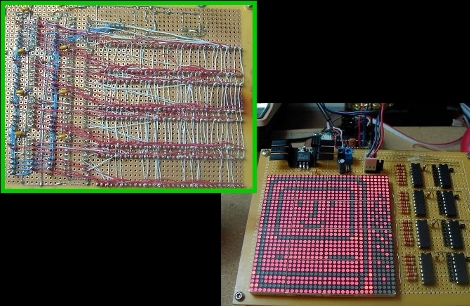
Regular reader [Osgeld] built a 1024 LED display matrix. This is a proof-of-concept design and he admittedly has overloaded the components. Most notably, the 595 shift registers (featured over the weekend) are sourcing too much current if all eight pins are active. That’s easy enough to fix in the next design by moving up to cascading LED drivers. Instead of soldering every connection in the display, [Osgeld] soldered the components in place and then used wire wrapping to make the point-to-point connections. This must have saved him a ton of time and frustration. We can’t wait to see what comes out of this first prototype.
















Wait – wire wrapping is suspected of saving him time and frustration?
Either I missed the sarcasm or it’s been a while since the author did any wire wrapping!
Yeah, I’m not sure why you would subject yourself to the pain of wirewrap. That’s a huge number of LEDs, though!
no it didnt save a ton of time and frustration, it took for freakin ever, and the radio shack equipment I used did not help much
Why did I do it with wirewrap? I never have done it before
also the overloading problem has been cured, I piggybacked another set of 595’s on top so they only handle half of what they did
its in the thread, but I havent posted a pic of that, since its mostly the same
it looks gorgeous
“Instead of soldering every connection in the display, [Osgeld] soldered the components in place and then used wire wrapping to make the point-to-point connections.” Makes no sense.
Should read: “Instead of soldering every LED connection in the display, [Osgeld] used LED arrays which reduced the number of solder joints considerably. Rather than printing a board, he used wire-wrap to make the connections.”
what was the size of those arrays? My 8x8s have 16 pins on them. sure beats 128 solder joints per 64LEDs!!!
8×8 16 pin, but they are small, like 1×1 inches
Nice work! I’m always amazed by the old-school beauty of wire wrapping.
You could replace your 595s wire high power versions: TPIC6B595. These a capable of sinking 150mA per pin.
That is an insane wire wrap project.
Last wire wrap I did was 50 wires, and that was enough to convince me to get a proto board built from then on!
The board looks cool….the sort of thing I think about doing but never actually decide to do…
Wow, looking at all that wire wrap makes me want to cut myself… Good job. That looks pretty intense!
lol wire wraping my old high school project comes to mind building a 8 bit computer from scratch an a few 74XX logic modules every thing wirewraped. the cable density on the back of the board enden up so bad that the logic gates would “missfire/missread” the inputs so altought the theorie was sane you bet that 8 bit piece of junk never worked properly aahhhhhhh good memories :P
Awesome. The back of the board looks as pretty to me as the front. It must have been very satisfying to finish.
I feel sadistic.
Could you not get a cheap bag’o’transistors to drive the LED’s instead of driving them with the shift registers..
I got a cheap bag o transistors, to take the load off of the shift registers, but did not have board space, … well I did but anyway
simplicity (being a cheap/lazyass) was the goal
currently with the piggybacked 595’s, and the ghetto design of every row shares a single led’s max current, if I turn on the entire screen at once, that 7805 regulator sees ~650ma (not including the cpu driving it), hence the fairly large area heatsink
PS: for the record, I actually wirewrapped this twice, cause I f*ked up the first time
at that point it was like “well screw it, I am quick at it now” and “its just easier to start over rather than to debug”
wirewrapping is way faster and easier than trying to solder jumper wires on pad-per-hole board.
I’ve never wire-wrapped a circuit board, but a lot of telecom uses wire-wrap instead of punch-down. It’s much more mechanically stable, the terminals are cheaper, and you can rework a given terminal dozens of times without wearing it out.
I just found a 30ga bit for my gun (most of my telecom experience is with 22 and 24), and I think I’ll try wirewrap for a circuit next time it’s appropriate.
@error404: And designing a two-layer circuit board, etching it and soldering everything together is even faster. And at the end you have a beautiful looking device, that can actually be used without risk of falling apart.
also areospace tech still uses it due to the cold welding effect tween the wire and the post
I have to admit on square post its really really stuck on there good, even the places where I cheated and used wirewrap to round component leads, if done right is surprisingly secure requiring a wire stripping action to remove the coils